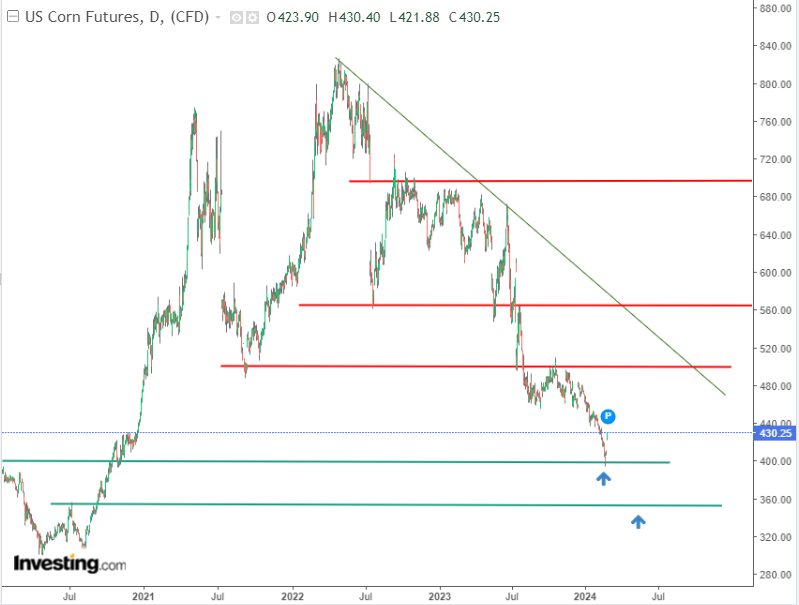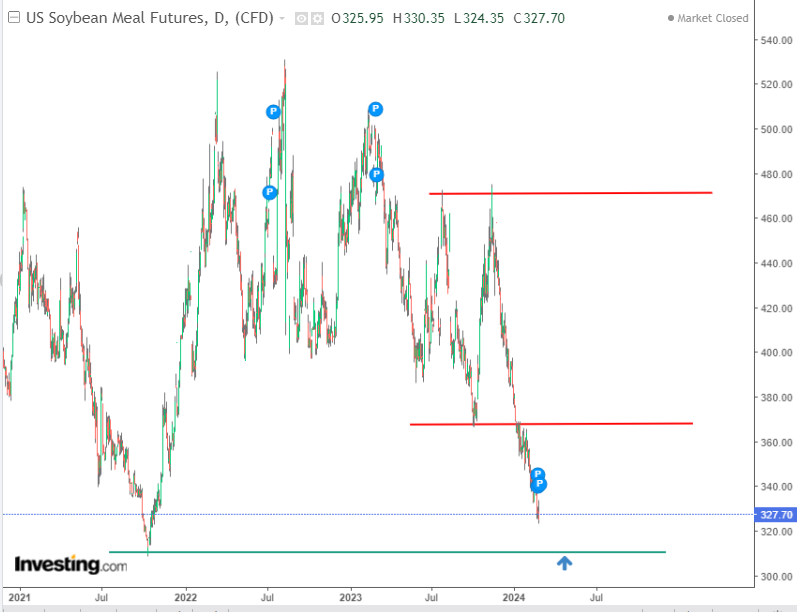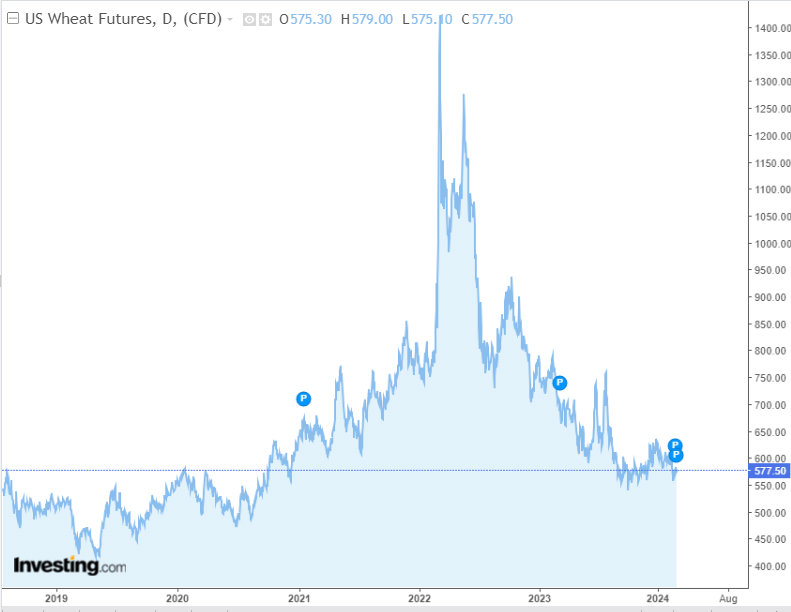- World record corn harvests have led to a decline in prices.
- Meanwhile, soybean prices are approaching 2021 lows.
- Ukraine and Russia's pricing advantage gives them an edge in the global wheat market.
- In 2024, invest like the big funds from the comfort of your home with our AI-powered ProPicks stock selection tool. Learn more here>>
Since the beginning of the year, key agricultural commodities like corn, soybean, wheat, and rapeseed have seen strong price declines.
The only exception has been rice, which has gained just under 5% and with prices maintaining an uptrend, driven in part by export restrictions from India.
This price decline in the global grain market is due to the increased supply and high inventory levels.
However, if grain prices continue to head lower, farmers may be left with no choice but to sell their stock to avoid further losses, making supplies spiral higher in the global market.
Corn: Could Prices Breach Key Support Level?
Since June 2022, corn prices have been on a downward trend, triggered by the initial supply shock resulting from Russia's actions in Ukraine, both major players in the grains market.
In the early months of this year, prices have continued to drop, experiencing losses exceeding 8%.
The persistent decline in prices is influenced by record harvests, particularly in Brazil and the United States. The US saw a record harvest in 2023.
Additionally, the focus is now on corn exports from Ukraine and Russia. The lure of low prices is prompting Chinese importers to increase their deliveries, impacting global markets with further price declines.
While the decline has slowed at the $400 per bushel threshold, the high inventory levels in both the US and Europe, coupled with the anticipated 10 million-ton increase in global reserves this year, could continue to push prices lower.

If bears break through $400, the next target appears to be in the range of $360-$350.
Soybean: Bears Eye 2021 Lows
Ukraine achieved record soybean exports by the end of last year.
The supply side is further supported by Brazil's rapidly growing harvests, reaching 38% this year compared to the previous year's 34%.
This combination is reinforced by elevated inventory levels in the US and reduced demand from China.
Since the start of the year, soy prices have already dropped by over 15%. Bears are eyeing the 2021 lows, slightly above $300 per ton, making it the most likely scenario for the coming weeks. 
Wheat: The Black Sea Basin to Dictate Prices
Wheat prices have been in a downtrend and have lost over 8% since the beginning of the year.
The pressure for declines is primarily coming from the Russian and Ukrainian markets, offering extremely competitive raw material prices. In Black Sea ports, prices range from $220 to $170 per ton.
Current declines may lead to the test of a crucial support area in the $540 per bushel range. If this unfolds, it could pave the way for the next key support test at $500. 
Ukrainian price competition has sparked widespread protests from European farmers.
They are currently finding it hard to compete given the stringent quality standards required in the European Union.
***
Take your investing game to the next level in 2024 with ProPicks
Institutions and billionaire investors worldwide are already well ahead of the game when it comes to AI-powered investing, extensively using, customizing, and developing it to bulk up their returns and minimize losses.
Now, InvestingPro users can do just the same from the comfort of their own homes with our new flagship AI-powered stock-picking tool: ProPicks.
With our six strategies, including the flagship "Tech Titans," which outperformed the market by a lofty 1,183% over the last decade, investors have the best selection of stocks in the market at the tip of their fingers every month.
Subscribe here and never miss a bull market again!
Now with CODE INWESTUJPRO1 you can get as much as a 10% discount on InvestingPro annual and two-year subscriptions.
Disclaimer: This article is written for informational purposes only; it does not constitute a solicitation, offer, advice, or recommendation to invest as such it is not intended to incentivize the purchase of assets in any way. I would like to remind you that any type of asset, is evaluated from multiple points of view and is highly risky and therefore, any investment decision and the associated risk remains with the investor.

